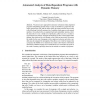Free Online Productivity Tools
i2Speak
i2Symbol
i2OCR
iTex2Img
iWeb2Print
iWeb2Shot
i2Type
iPdf2Split
iPdf2Merge
i2Bopomofo
i2Arabic
i2Style
i2Image
i2PDF
iLatex2Rtf
Sci2ools
ATVA
2009
Springer
2009
Springer
Automated Analysis of Data-Dependent Programs with Dynamic Memory
We present a new approach for automatic verification of data-dependent programs manipulating dynamic heaps. A heap is encoded by a graph where the nodes represent the cells, and the edges reflect the pointer structure between the cells of the heap. Each cell contains a set of variables which range over the natural numbers. Our method relies on standard backward reachability analysis, where the main idea is to use a simple set of predicates, called signatures, in order to represent bad sets of heaps. Examples of bad heaps are those which contain either garbage, lists which are not well-formed, or lists which are not sorted. We present the results for the case of programs with a single next-selector, and where variables may be compared for (in)equality. This allows us to verify for instance that a program, like bubble sort or insertion sort, returns a list which is well-formed and sorted, or that the merging of two sorted lists is a new sorted list. We report on the result of running a...
Related Content
| Added | 26 May 2010 |
| Updated | 26 May 2010 |
| Type | Conference |
| Year | 2009 |
| Where | ATVA |
| Authors | Parosh Aziz Abdulla, Muhsin Atto, Jonathan Cederberg, Ran Ji |
Comments (0)

